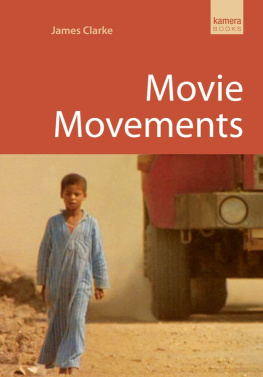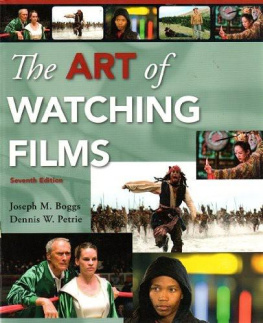ACKNOWLEDGMENTS
Great film teachers who have inspired me include Antonia Lant, the late Robert Sklar, and especially Tom Gunning, whose brilliance and passion continue to set the bar for my highest aspirations in the classroom. A legendary teacher I never took a class with is Louis Giannetti, who taught film studies at Case Western in the years before my coming and who, when I got here, generously shared teaching tips and techniques with me that hed honed over three decades. The lessons, philosophies, and enthusiasm of these mentors have gone into this book, as has the ongoing enrichment I gain from my students. At Case Western, thanks to my colleagues in the English Department and to William Claspy and Gayle Spinazze. At the University of California Press, thanks to Rachel Berchten, Sandy Drooker, Kim Hogeland, and especially Mary Francis, for her encouragement, guidance, and wonderful editorial eye. Im grateful to the anonymous readers for their helpful comments, Rick Worland for his insights and advice, and Joe Abbott for his copyediting. Thanks to my parents, Norma and Ed Spadoni, for finding my author photo in the attic and for everything else theyve done. To my children, Nora, Louise, and Matilda, thanks for making the world go round, and an extra hug goes to Nora for proofreading the manuscript. Finally, Diana Simeon supported the making of this book in so many ways. To her I express my deepest love and gratitude.
The major components of a narrative film.
Introduction
A Pocket Guide to Analyzing Films is founded on the belief that most any film can be better understood and appreciated when it is viewed as a system in which the parts relate to each other and together make up the whole. Thinking about a film in this way is sometimes called close reading and sometimes textual analysis. We will call it formal analysis.
Because it focuses exclusively on describing the methods of formal analysis, and on making a case for their usefulness regardless of ones specific interest in the cinema, this book leaves out a lot of things. It concentrates on those aspects of the film-viewing experience that dont change, or have changed the least, over time. Theres nothing, or close to it, on silent versus sound cinema, IMAX, Technicolor, YouTube, and 3-D. And theres a minimum on how techniques are executed, on behind-the-scenes production realities like optical printers, performance capture suits, Final Cut Pro, and stunt doubles. The focus, instead, is on the results of these efforts, what happens on the screen, the functions and effects of these techniques both individually and, more important, when they work together. There is little mention of the turn to digital cinema in recent years, because the thing that well be calling film form has not been remade by this change. The methods, terminology, and target of the kind of analysis described in this book have not experienced the upheavals currently sweeping the worlds cinema institutions, technologies, and economies. Theres no overview of the movie business today or even a snapshot of movie history. And this isnt a how-to guide for aspiring filmmakers. That said, filmmakers who want to learn more about how films shape the viewing experience will find here a concise road map to the tools and principles that govern this dynamic and richly complex process.
The key word is concise . This Pocket Guide is designed to be just that, small enough to have with you whenever and wherever you might need it, both in and out of class. What it lacks in breadth and depth, I hope it makes up for with portability. Provided is only what youll need to be able to sift through the elements that make up a film, regardless of your particular interest or orientation to it. Your interest might be in learning more about how films cohere and work their effects. Or maybe you have a more focused goal. You might be taking a course in film theory (classical, semiotic, or cognitivist, for example), or on a genre (science fiction, musicals, film noir, etc.), or a survey of movie history, or a course on race and gender in film, the French New Wave, cinemas of the Pacific Rim, Alfred Hitchcock, film adaptation, or any of a hundred other possibilities. Such a course will expose you to readings that will help you explore its specific topical material. But the heart of your inquiry, regardless of the course focus, will be films. This book, as much as possible, cuts across historical and national boundaries, driving at all times toward the common core of elements that make up films of virtually every kind. Here are the specialized terms and concepts that you will need to make formal analysis the robust center of a persuasive film essay.
Described are not only film techniques but also more general ideas that will help you make sense of those techniques. You notice that a shot is filmed from a low angle. Why should you or anyone else care? A major reason is that you can organize things like camera angles into patterns that will help you ask, and answer, big questions about a film, including what it means. More valuable than helping you articulate what you think is going on in a film, these principles can help you discover what is going on. Most of these principles are described in part 1, in chapter 1, the longest and most important chapter in the book.
The images in this book are digital captures from films, not production stills, which are photographs taken on the film set for promotional purposes and not accurate representations of how the film looks on the screen. Youll also find thumbnail readings of a selection of films and film sequences, pointers on writing a film essay, and notes on areas of possible confusionlike terms that sound alike but mean different things, and ones that mean similar or overlapping things. I try to clear these up as I go. I urge you to flag them with your pen or highlighter as you go.
















